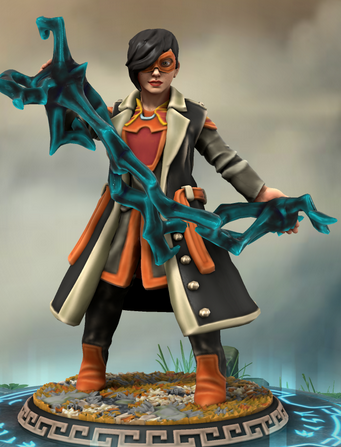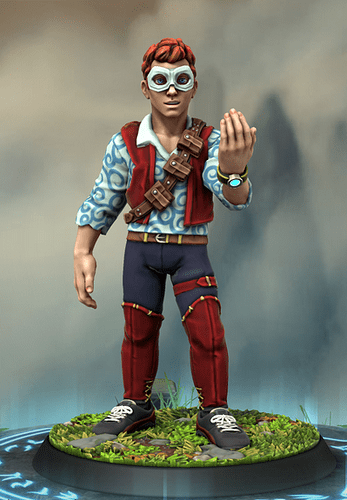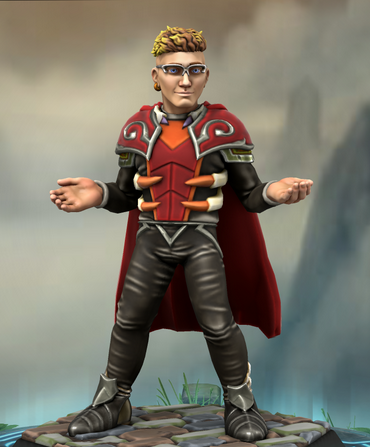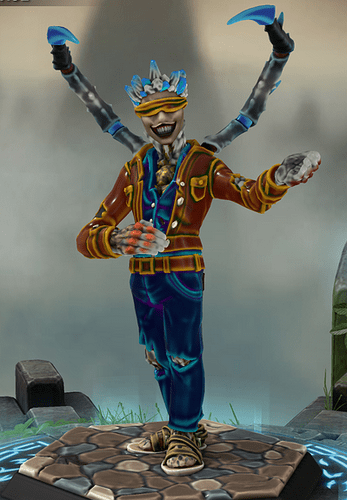The Randomizers:
Background 6, 8, 10 [Options: Upper Class, Struggling, Unremarkable Dynasty, Interstellar, Created, Exile]
Power Source 8, 4, 2 [Options: Training, Experimentation Mystical, Nature, Powered Suit, Tech Upgrades]
Archetype 7, 8, 4 [Options: Marksman, Armored, Flyer, Sorcerer, Psychic, Wild Card]
Personality 2, 10, 5 [Options: Natural Leader, Sarcastic, Stalwart, Alluring, Nurturing, Jovial]
Heretic

Real Name: Grace Hunter, First Appearance: Heretic #1, November 2005
Background: Struggling, Power Source: Mystical, Archetype: Sorcerer
Personality: Sarcastic, Principles: Underworld, Compassion
Status Dice: Green d8, Yellow d8, Red d10. Health: 32 [Green 32-25, Yellow 24-12, Red 11-1]
Qualities: Ranged Combat d10, Otherworldly Mythos d10, Conviction d10, Criminal Underworld d8, Banter d6, Demon Shape d8
Powers: Infernal d10, Suggestion d8, Wall-Crawling d8, Illusions d8, Teleportation d6
Green Abilities:
-
The Weight of Your Sins [A]: Attack using Infernal. Hinder that same target using your Min die.
-
Your Hidden Hopes [A]: Hinder using Illusions. Use your Max die. If you roll doubles, also Attack using your Mid die.
-
Principle of the Underworld [A]: Overcome a problem related to your knowledge of the criminal underworld or using one of your contacts and use your Max die. You and each of your allies gain a hero point.
-
Principle of Compassion [A]: Overcome to connect with an individual on a personal level and use your Max die. You and each of your allies gain a hero point.
Yellow Abilities:
-
Infernal Energies [A]: Boost or Hinder using Infernal, and apply that mod to multiple nearby targets.
-
Honour Among Thieves [A]: Attack multiple targets near each other using Suggestion.
-
The Demon Within [A]: Destroy one d6 or d8 minion. Roll that minion’s die as an Attack against another target.
-
Sacrifice [R]: When another hero in the Yellow or Red zone would take damage, you may redirect it to yourself and Defend against it by rolling your single Suggestion die.
Red Abilities
-
Sin-Eater [A]: Select a minion. That minion is now entirely under your control and acts at the start of your turn. If you are incapacitated, you lose control of this minion. You may also choose to release control of this minion at any time. At the end of the scene, this minion is defeated.
-
Soul Chains [A]: Remove a bonus on a target. Hinder that target using Otherworldly Mythos. Use your Max die, and that penalty is persistent and exclusive.
Out
- Hinder an opponent by rolling your single Alertness die.
Heroic Lieutenant: Holden Lance
First Appearance (as spirit): Heretic #1, November 2005
- D10 Lieutenant
-
Spirit Touch: Holden cannot Attack physical beings or Defend against physical attacks.
-
Spirit Form: Holden is immune to physical damage.
Grace Hunter’s first life ended the way it started: wet and alone.
Grace had been a foundling, left on the doorstep of a church on a rainy morning twenty years earlier. She moved between homes often as a child, bouncing back and forth between the church and various foster homes, before being taken in by a poor but loving family at the age of ten. She grew up seeing her neighborhood get worse as the mobs moved in, and started working for them before she was a teenager, running messages and scams to help support her adopted family and friends.
When Grace was twenty, her luck ran out. She scammed the wrong person, got caught, and the local gang boss decided to make an example of her. Three men took her out in a motorboat, chained her up, and tossed her overboard. That was the end of her first life. But as Grace sank into the waters of the bay, she heard a whispering voice. It told her that she could survive, and have the power to lay her enemies low, but the cost would be her soul, and she would be forever beholden to the Heretic’s Creed.
Grace didn’t believe in souls, didn’t believe in creeds, and definitely didn’t believe in demonic voices whispering to her. But also, she was about to drown and figured she had nothing to lose, so she said yes.
The three gangsters were therefore shocked when the water they’d just tossed Grace into boiled, black lightning lanced up from it, and a girl glowing with infernal power erupted out of the waves and shattered their boat beneath them while throwing dark energy into their faces. They were even more surprised when she scooped their battered bodies out of the churning waters and dumped them on the shore instead of leaving them to drown, and absolutely shocked when she sat down on top of them and lectured them about their life choices, pulling out their hidden insecurities and hopes to convince them that they’d taken a really bad turn in life, but there was still time to change and not end up torn into confetti-sized bits of flesh. All three promised her that they would do better, and she promised them she’d be checking up on them to make sure that they did.
And that was how Grace became the Heretic. As it transpired, the demonic voice she’d heard was that of Holden Lance, the first Heretic, as he sealed the Sovereign of Secrets away and desperately searched for a replacement lock to the eldritch being’s cage. Holden’s options were limited to those on the verge of death, and Grace’s soul shone like a beacon to him. He hoped that, even damned, she would be a force for good in the world. He got more than he bargained for. Grace was sarcastic, quick to throw a punch, and bitterly cynical about the state of the world. She had also always sworn to herself that if she had power, she wouldn’t be like the people who ruined her life. She would give people a chance. Help them. And suddenly, she had all the power in the world, power that could destroy lives and ruin spirits, and she resolved to live by the most heretical idea of all: that no one was beyond redemption.
Heretic was an odd comic. The editors of Venture wanted a throwback to the gritty, over-the-top action epics of the early 90s, but the comic’s lead writer thought the whole concept was ridiculous, and used Grace to explore that. Her enemies were extreme, and she would throw herself into fights against them, then sit down next to them as they laid on the ground and talk through why the hell they thought this was a good idea. She actually listened to her foes. She helped them - after beating them halfway to hell, of course. And she resonated with the cynical readers of the early 2000s, who wanted to see a better world but weren’t sure there was a way to reach it without violence. She managed to ride the line between earnest and ironic, and what everyone had initially expected to be a flash in the pan comic while Venture thought of a better idea ended up running for thirteen years, becoming a minor fan favourite along the way.
Behind the Scenes
And that is our last hero!
When I launched a Heretic comic during the Plutonium Age, I figured there was a good chance that it would be gone within a couple events; the system was deliberately rigged a bit against the newest comics lasting. But it didn’t. It made it all the way, with the result that now I had a pretty substantial comic in my lineup featuring a hero I’d never written up. So I wanted to fix that, and the result is Heretic; someone drawing on the culture of the early 2000s to really ride the line between a cynical joke and an earnest desire to make the world a better place.
Her powers underline that - she can really mess with people’s brains, and she absolutely will to mess you up, but she can also show you that there’s a better path and convert minions to her side. She’s essentially halfway between Ghost Rider and Squirrel Girl.
Tomorrow, we start our villains with Heretic’s biggest nemesis, and then we’ll have seventeen more villains who are actually from the Diamond Age.




